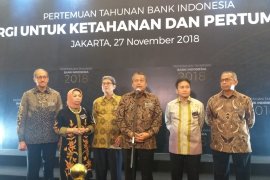The report said Indonesia was considered to have a sound and properly controlled inflation rate, credit growth, interest rates, currency exchange movements (against the US dollar) and state budget.
Indonesia along with China and Saudi Arabia had the largest capacity to use monetary and fiscal policies to support their economic growth.
"Chile, Peru, Russia, Singapore and South Korea deserve the same appreciation," the report said.
Meanwhile, economic conditions in Argentina, Brazil, Hungary, Turkey, Pakistan and Vietnam were more worrying than in Egypt, India and Poland, which were the same situation but had space for fiscal stimulus.
Economic growth in Brazil and India was predicted to slow down, compared to China because of a lack of adequate fiscal and monetary policies.
"India`s fiscal policy is inadequate to overcome the high inflation rate, and the Central Bank of India did not cut interest rates even though the economy is slowing. on the contrary the Brazilian Central Bank has lowered interest rates four times since August last year," as mentioned in the The Economist`s report.
The crisis will begin impacting developing countries and lowering 2011 fourth quarter growth forecast at 3.0 percent, from 6.5 percent in the first quarter.
Due to the economic slowdown, some countries issued a tightening policy to protect the "overheating" possibility and restrain the inflation.
However, there would be a decline in export and capital flows.
"If the European debt crisis worsened, then the situation in developing countries would not be improving," the report said.
The good news is that developing countries will still have adequate monetary and fiscal policies space, while developed countries have little space to cut interest rates or increase lending.
Adequate monetary and fiscal are the only space in developing countries to withstand the 2008-2009 crisis of being able to the demand and make the private sector in prime condition.
Currently developing countries� state budget deficit only reached 2.0 percent of the GDP compared to countries who are members of the G7 group that reached 8.0 percent.
"The ratio of developing countries` government debt to GDP also reached 36 percent of GDP, compared to 119 percent achieved the developed world," the report said.
Based on the situation, The Economist has classified index of 27 developing countries on five indicators that have been mentioned, on the economic conditions that occurred lately.
The report said that Taiwan experienced the lowest inflation rate of 2.0 percent and the highest in Argentina and Venezuela by more than 20 percent.
But the average developing country has an inflation of 5.0 percent due to decline in food prices.
Then, the concerning credit growth appears in Argentina, Brazil, Hong Kong and Turkey, compared to bank loans in China which are now improved more than their GDP.
With negative average interest rate, Brazil and China get a 2.0 percent rate last year. While the Brazilian, Hungary, India and Poland currency experienced a double-digit depreciation against the U.S. dollar with the risk of increased import prices and boosts inflation.
Last indicator is the balanced and healthy state budget, in which Turkey is the most vulnerable country because of the budget deficit is predicted to reach 9.0 percent of the 2012 GDP, while India, Poland and South Africa struggled to maintain rates 4.0 percent or more.
Meanwhile, countries such as Brazil, Hungary, Egypt, India, Pakistan and Poland have a debt to GDP ratio on average 60 percent where the last four countries also have a budget deficit of 6.0 to 9.0 percent.
"Russia, Singapore and South Korea have large room for fiscal stimulus," the report said. (*)
Editor: Aditia Maruli Radja
Copyright © ANTARA 2012











